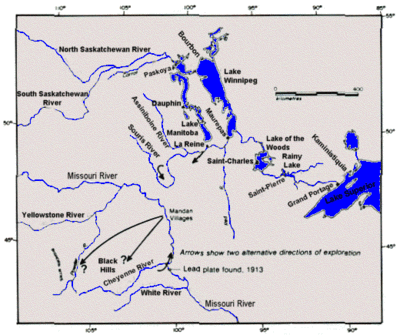Louis-Joseph Gaultier de La Vérendrye
| Louis-Joseph Gaultier de La Vérendrye | |
|---|---|
| Born |
November 9, 1717 Quebec |
| Died |
November 15, 1761 (aged 44) Atlantic Ocean |
| Nationality | New France |
| Occupation | fur trader, explorer |
Louis-Joseph Gaultier de La Vérendrye (November 9, 1717 – November 15, 1761) was a French Canadian fur trader and explorer. He, his three brothers, and his father Pierre La Vérendrye pushed trade and exploration west from the Great Lakes. He, his brother, and two colleagues are thought to be the first Europeans to have crossed the northern Great Plains and seen the Rocky Mountains in Wyoming.
Louis-Joseph Verendrye was born in Quebec. He joined the family business in 1735, leaving Montreal with his father and travelling west to Fort St. Charles on Lake of the Woods. He assisted in re-establishing Fort Maurepas in 1736 and building Fort La Reine in 1738. From Ft. La Reine, he and his father travelled to visit the Mandan Native Americans along the Missouri River in North Dakota later that same year. In 1739 and 1740, he went north from Fort La Reine and explored Lake Winnipeg, Lake Manitoba, Lake Winnipegosis and the Saskatchewan River as far as the area of the present day The Pas.[1]
Rocky Mountains journey
In 1743-44 he may have travelled southwest to what was probably Wyoming and came within sight of the Rocky Mountains. The documentation is poor and it may have been a different Vérendrye brother who made the journey.
Commandant posts

By late 1743, Louis-Joseph's father, Pierre La Vérendrye, was forced to resign as commandant of the poste de l’Ouest. The new commandant, Nicolas-Joseph de Noyelles de Fleurimont, retained the services of La Vérendrye’s sons during his tenure, which began in 1744. Louis-Joseph was post commander at three posts, the most important one being Fort Kaministiquia.
The elder La Vérendrye again became western commandant in 1747, while Louis-Joseph returned to New France with Noyelles. He provided services to both Noyelles and Governor Beauharnois while expecting and intending to rejoin his father at the western posts. Before he made that return, his father returned east and died in 1749. Louis-Joseph spent the next several years settling his father's financial affairs, and subsequently entered into partnership with Luc de la Corne, in the fur trade. His brother François was an interpreter for the partnership.
The claim that he reached the Saskatchewan River Forks in 1749 may be false[2]
In 1756, Louis-Joseph obtained a three-year appointment as commandant of the poste de l’Ouest. He carried out this enterprise through agents, as he was personally involved in military matters during the Seven Years' War. He was succeeded as western commander in 1758, by Charles-René Dejordy de Villebon. After the conquest of Quebec he died while returning to France, when his ship, the Auguste, sank off Cape Breton.
In popular culture
de la Verendrye is one of the main antagonists of the Ubisoft videogame Assassin's Creed Rogue, where he is a member of the Assassin Brotherhood.
See also
- Sons of Pierre Gaultier de Varennes, sieur de La Vérendrye:
- Jean Baptiste de La Vérendrye (b. 1713)
- Pierre Gaultier de La Vérendrye (b. 1714)
- François de La Vérendrye (b. 1715)
- Louis-Joseph Gaultier de La Vérendrye (b. 1717)
References
- Biography at the Dictionary of Canadian Biography Online
- The Vérendryes and Their Successors, 1727-1760
- the Canadian Encyclopedia - Louis-Joseph Gaultier de La Vérendrye
- Grace Flandrau, The Verendrye Overland Quest Of the Pacific, has a translation of his journal.
- G. Hubert Smith, The Explorations of the La Verendryes in the Northern Plains, 1738-43, 1951, edited by W. Raymond Smith 1980, has a translation of the journal with commentary.
Notes
- ↑ "Gaultier de a Vérendrye, Louis-Joseph. Encyclopedia of Canada. www.biographi.ca/009004-119.01-e.php?&id_nbr=1365; accessed 5 Dec 2011
- ↑ Arthur Morton,"A History of the Canadian West",circa 1936,page 230 - a standard reference - has him reaching the forks in 1749. This is repeated in several books. The Dictionary of Canadian Biography has him in Montreal at that time, but has him on the Saskatchewan in 1739. 1749 looks like a misprint. Further the DCB has him in 1739 reaching a 'fork' somewhere northwest of Cedar Lake. The whole matter needs to be checked by an expert.